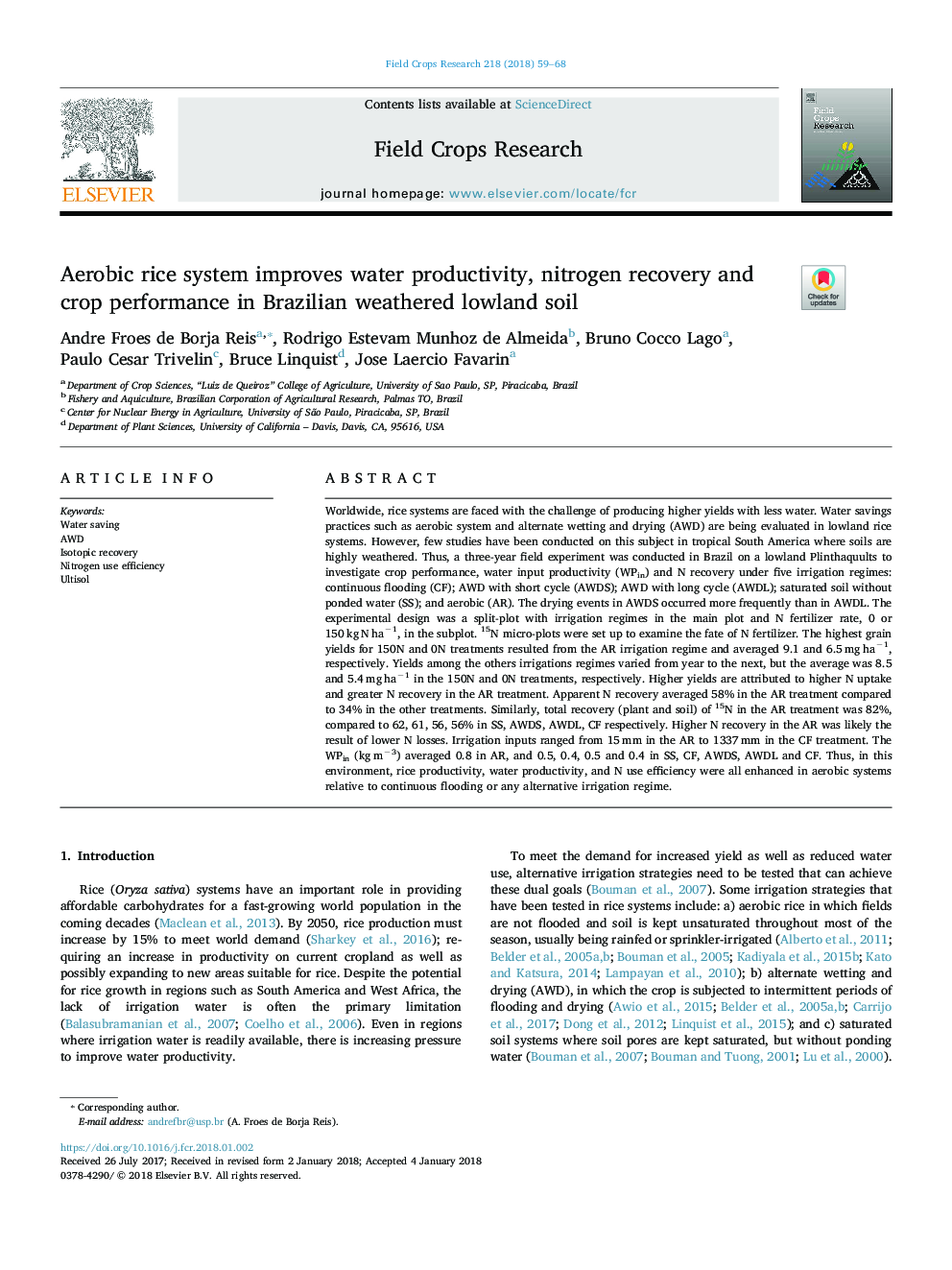| کد مقاله | کد نشریه | سال انتشار | مقاله انگلیسی | نسخه تمام متن |
|---|---|---|---|---|
| 8879351 | 1624645 | 2018 | 10 صفحه PDF | دانلود رایگان |
عنوان انگلیسی مقاله ISI
Aerobic rice system improves water productivity, nitrogen recovery and crop performance in Brazilian weathered lowland soil
ترجمه فارسی عنوان
سیستم برنج ایروبیک، بهره وری آب، بازیابی نیتروژن و عملکرد محصول را در خاک نزولی باران برزیل بهبود می
دانلود مقاله + سفارش ترجمه
دانلود مقاله ISI انگلیسی
رایگان برای ایرانیان
کلمات کلیدی
موضوعات مرتبط
علوم زیستی و بیوفناوری
علوم کشاورزی و بیولوژیک
علوم زراعت و اصلاح نباتات
چکیده انگلیسی
Worldwide, rice systems are faced with the challenge of producing higher yields with less water. Water savings practices such as aerobic system and alternate wetting and drying (AWD) are being evaluated in lowland rice systems. However, few studies have been conducted on this subject in tropical South America where soils are highly weathered. Thus, a three-year field experiment was conducted in Brazil on a lowland Plinthaquults to investigate crop performance, water input productivity (WPin) and N recovery under five irrigation regimes: continuous flooding (CF); AWD with short cycle (AWDS); AWD with long cycle (AWDL); saturated soil without ponded water (SS); and aerobic (AR). The drying events in AWDS occurred more frequently than in AWDL. The experimental design was a split-plot with irrigation regimes in the main plot and N fertilizer rate, 0 or 150â¯kgâ¯Nâ¯haâ1, in the subplot. 15N micro-plots were set up to examine the fate of N fertilizer. The highest grain yields for 150N and 0N treatments resulted from the AR irrigation regime and averaged 9.1 and 6.5â¯mgâ¯haâ1, respectively. Yields among the others irrigations regimes varied from year to the next, but the average was 8.5 and 5.4â¯mgâ¯haâ1 in the 150N and 0N treatments, respectively. Higher yields are attributed to higher N uptake and greater N recovery in the AR treatment. Apparent N recovery averaged 58% in the AR treatment compared to 34% in the other treatments. Similarly, total recovery (plant and soil) of 15N in the AR treatment was 82%, compared to 62, 61, 56, 56% in SS, AWDS, AWDL, CF respectively. Higher N recovery in the AR was likely the result of lower N losses. Irrigation inputs ranged from 15â¯mm in the AR to 1337â¯mm in the CF treatment. The WPin (kgâ¯mâ3) averaged 0.8 in AR, and 0.5, 0.4, 0.5 and 0.4 in SS, CF, AWDS, AWDL and CF. Thus, in this environment, rice productivity, water productivity, and N use efficiency were all enhanced in aerobic systems relative to continuous flooding or any alternative irrigation regime.
ناشر
Database: Elsevier - ScienceDirect (ساینس دایرکت)
Journal: Field Crops Research - Volume 218, 1 April 2018, Pages 59-68
Journal: Field Crops Research - Volume 218, 1 April 2018, Pages 59-68
نویسندگان
Andre Froes de Borja Reis, Rodrigo Estevam Munhoz de Almeida, Bruno Cocco Lago, Paulo Cesar Trivelin, Bruce Linquist, Jose Laercio Favarin,
